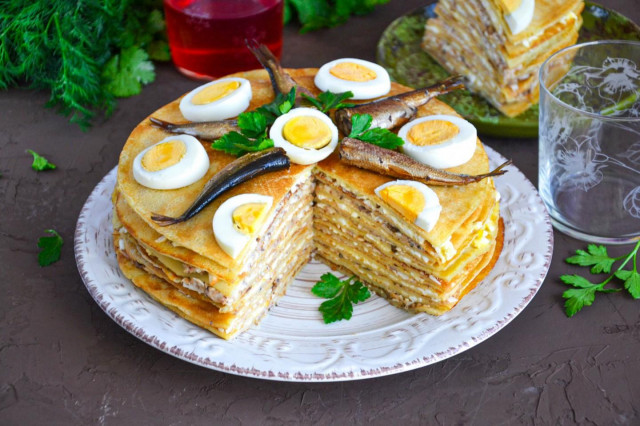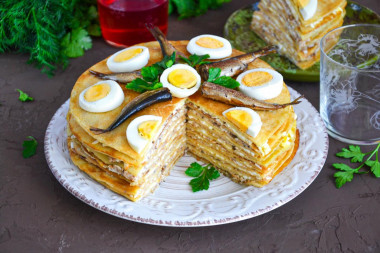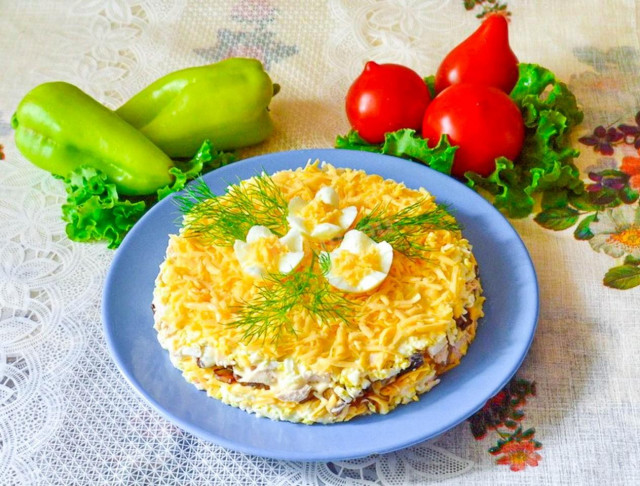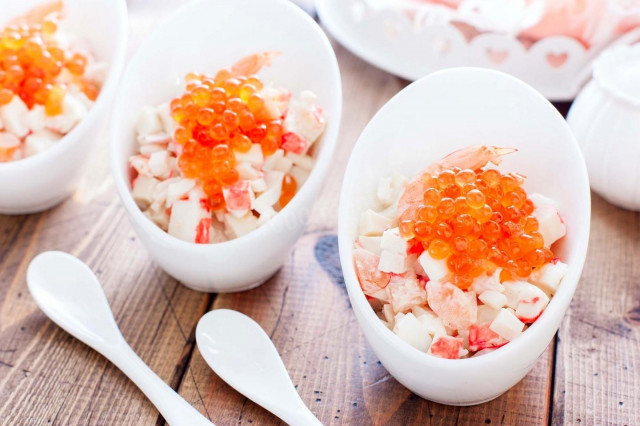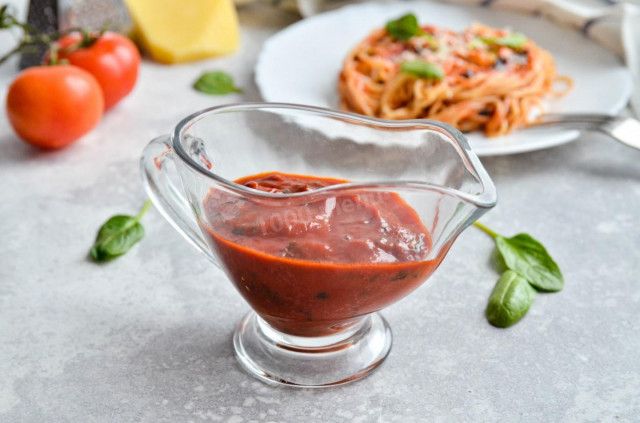Composition / ingredients
Step-by-step cooking
Step 1:
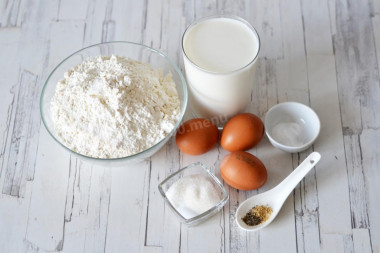
How to make unsweetened pancake cake? Prepare the products. Take the milk and eggs out of the refrigerator in advance — the dough is better kneaded on warm foods. Add ginger and pepper to taste, they are not mandatory ingredients.
Step 2:

Prepare the pancakes first. How to make pancakes? Beat the eggs into a bowl of suitable size. Be sure to wash the eggs before use, as even the seemingly clean shell may contain harmful bacteria. It is best to use food detergents and a brush. Beat the eggs with salt and sugar. You can use both a mixer and a conventional whisk.
Step 3:
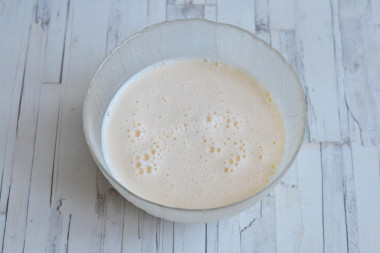
Pour warm milk and warm water to the eggs, mix.
Step 4:
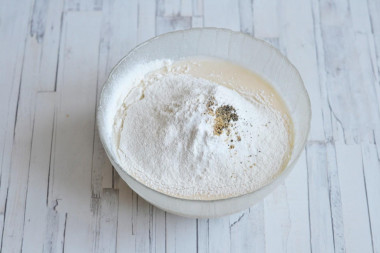
Sift flour and soda into the dough and mix. Sifting will not only remove possible debris from the flour, but also enrich it with oxygen — pancakes will turn out softer and more lush. Add ground pepper, salt and ground ginger.
Step 5:
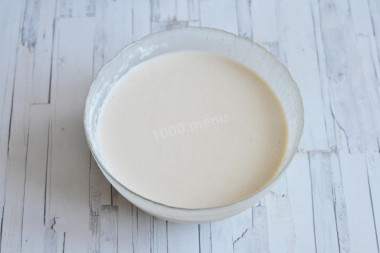
Mix the dough until the lumps disappear. You should get a slightly viscous dough. If the dough is too thick, dilute it with warm water or warm milk to the desired consistency. If, on the contrary, the dough turns out to be more liquid than necessary, pour in a little more sifted flour. A lot depends on the size of the eggs and the quality of the flour. Let the dough stand for 10-15 minutes so that the flour absorbs all the liquid, this will improve its properties.
Step 6:
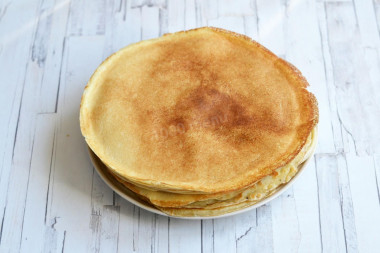
In a greased frying pan, bake the pancakes on both sides until golden brown. Stack the finished pancakes on top of each other.
Step 7:
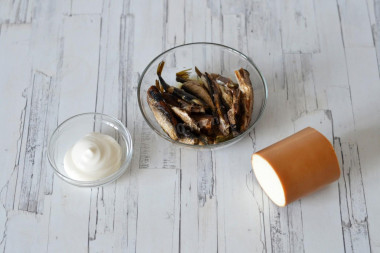
Prepare the products for the cheese-sprat filling. Sausage cheese can be replaced with any other cheese: processed cheese of the Druzhba type, Amber or ordinary hard cheese of the Russian type. Choose natural cheese, without vegetable additives. Remove the sprats from the jar, removing the oil as much as possible.
Step 8:

How to make the filling? Mash the sprats with a fork.
Step 9:
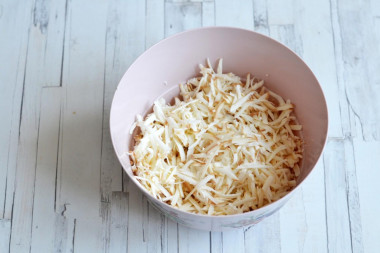
Grate the sausage cheese on a coarse grater.
Step 10:
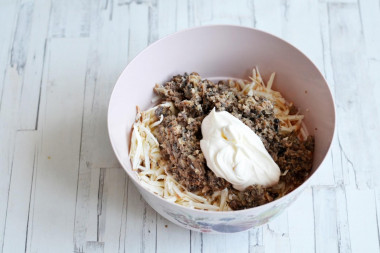
Combine sprats, cheese and mayonnaise. You can take store-bought mayonnaise or make it yourself at home.
Step 11:

Mix the filling well. The first filling is ready.
Step 12:

Prepare the products for the egg-garlic filling. Pre-boil the eggs and cool them. Peel the garlic from the husk.
Step 13:
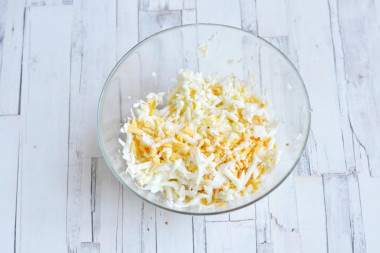
Peel and grate the eggs on a coarse grater.
Step 14:
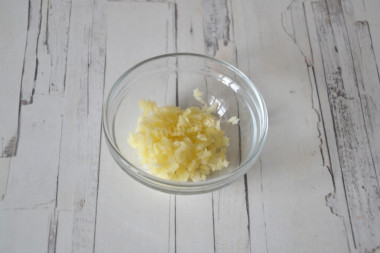
Pass the garlic through the press.
Step 15:

Combine eggs, garlic, mayonnaise, salt and pepper. Mix it up. The second filling is ready.
Step 16:
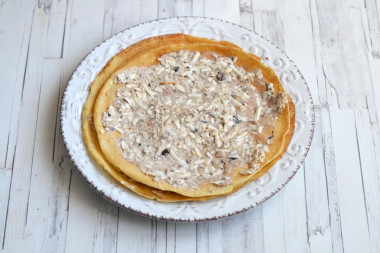
Assemble the cake. Put the first pancake on a large dish and grease it with sprat filling.
Step 17:

Cover with a second pancake and grease it with egg filling.
Step 18:

So, alternating fillings, form a tall cake. The smaller the diameter of the pan you had, the higher the cake will turn out. Do not lubricate the upper pancake.
Step 19:
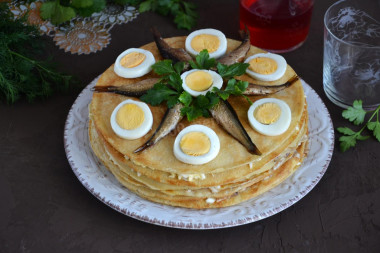
Decorate the top of the cake with sliced boiled egg, sprats and parsley. Put it in the refrigerator for impregnation for a couple of hours, then serve it to the table. Enjoy your meal!
How to cook hard-boiled eggs? So that the eggs do not crack when cooking, put them in cold water and put them to cook on a small fire. Boil the eggs for 9 minutes after boiling, then pour cold water and cool. From a sharp temperature drop, the shell will be better cleaned.
It is better to prepare mayonnaise yourself. It will be tastier and healthier. See here interesting
recipes for homemade mayonnaise.
Also, as a dressing, you can use not only mayonnaise, but also sour cream or natural yogurt. They can be taken separately or mixed with mayonnaise in any proportion to your taste - this will reduce the calorie content of the dish.
Important! An incorrectly selected frying pan can ruin even the best recipe. All the details on how to choose the perfect frying pan for different dishes read here .
Caloric content of the products possible in the composition of the dish
- Whole cow's milk - 68 kcal/100g
- Milk 3.5% fat content - 64 kcal/100g
- Milk 3.2% fat content - 60 kcal/100g
- Milk 1.5% fat content - 47 kcal/100g
- Concentrated milk 7.5% fat content - 140 kcal/100g
- Milk 2.5% fat content - 54 kcal/100g
- Chicken egg - 157 kcal/100g
- Egg white - 45 kcal/100g
- Egg powder - 542 kcal/100g
- Egg yolk - 352 kcal/100g
- Ostrich egg - 118 kcal/100g
- Garlic - 143 kcal/100g
- Ground black pepper - 255 kcal/100g
- Parsley greens - 45 kcal/100g
- Whole durum wheat flour fortified - 333 kcal/100g
- Whole durum wheat flour, universal - 364 kcal/100g
- Flour krupchatka - 348 kcal/100g
- Flour - 325 kcal/100g
- Granulated sugar - 398 kcal/100g
- Sugar - 398 kcal/100g
- Salad mayonnaise of 50 % fat content - 502 kcal/100g
- Light mayonnaise - 260 kcal/100g
- Provencal Mayonnaise - 624 kcal/100g
- Provencal mayonnaise - 627 kcal/100g
- Table mayonnaise - 627 kcal/100g
- Vegetable oil - 873 kcal/100g
- Sprats - 363 kcal/100g
- Salt - 0 kcal/100g
- Water - 0 kcal/100g
- Baking soda - 0 kcal/100g
- Sausage cheese - 268 kcal/100g
- Ginger Powder - 335 kcal/100g

